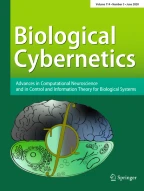436Accesses
183Citations
3 Altmetric
Abstract
Hind legs with crossed receptor-apodemes of the femoral chordotonal organ when making a step during walking often do not release the ground after reaching the extreme posterior position. After putting a clamp on the trochanter (stimulation of the campaniform sensilla) the leg is no longer protracted during walking. However, during searching-movements the same leg is moved very far forwards. The anatomical situation of the campaniform sensilla on the trochanter and the sensory innervation of the trochanter is described. After removal of the hair-rows and continuously stimulating the hair-plate at the thorax-coxa-joint the extreme anterior and posterior positions of the leg in walking are displaced in the posterior direction. Front and middle legs operated in this way sometimes do not release the ground at the end of retraction. In searching-movements the same leg is moved in a normal way. If only one side of a decerebrated animal goes over a step, then on the other side a compensatory effect is observed. The main source of this compensatory information appears to be the BF1-hair-plates. If the animal has to drag a weight the extreme anterior and posterior positions of the middle and hind legs are displaced in the anterior direction. Crossing the receptor-apodeme of the femoral chordotonal organ, when it causes the leg to remain in the protraction phase, displaces the extreme posterior position of the ipsilateral leg in front of the operated one in the posterior direction. Influences of different sources on the extreme posterior position can superimpose. A model is presented which combines both a central programme and peripheral sensory influence. The word “programme” used here means that it does not only determine the motor output but also determines the reactions to particular afferences. The fact that the reaction to a stimulus depends on the internal state of the CNS is also represented by the model.
This is a preview of subscription content,log in via an institution to check access.
Access this article
Subscribe and save
- Starting from 10 chapters or articles per month
- Access and download chapters and articles from more than 300k books and 2,500 journals
- Cancel anytime
Buy Now
Price includes VAT (Japan)
Instant access to the full article PDF.
Explore related subjects
Discover the latest articles, books and news in related subjects, suggested using machine learning.References
Bässler, U.: Zum Schweresinn von Mehlkäfern und Stechmücken. Z. Naturforsch.10b, 264–267 (1961)
Bässler, U.: Proprioreceptoren am Subcoxal- und Femur-tibia-Gelenk der StabheuschreckeCarausius morosus und ihre Rolle bei der Wahrnehmung der Schwerkraftrichtung. Kybernetik2, 168–193 (1965)
Bässler, U.: Zur Regelung der Stellung des Femur-Tibia-Gelenkes bei der StabheuschreckeCarausius morosus in der Ruhe und im Lauf. Kybernetik4, 18–26 (1967)
Bässler, U.: Zur Steuerung des Springens bei der WanderheuschreckeSchistocerca gregaria. Kybernetik4, 112 (1968)
Bässler, U.: Zur Bedeutung der Antennen für die Wahrnehmung der Schwerkraftrichtung bei der StabheuschreckeCarausius morosus. Kybernetik9, 31–34 (1971)
Bässler, U.: Zur Beeinflussung der Bewegungsweise eines Beines vonCarausius morosus durch Amputation anderer Beine. Kybernetik10, 110–114 (1972)
Bässler, U.: Zur Steuerung aktiver Bewegungen des Femur-Tibia-Gelenkes der StabheuschreckeCarausius morosus. Kybernetik13, 38–53 (1973)
Bässler, U.: Vom femoralen Chordotonalorgan gesteuerte Reaktionen bei der StabheuschreckeCarausius morosus: Messung der von der Tibia erzeugten Kraft im aktiven und inaktiven Tier. Kybernetik16, 213–226 (1974)
Bässler, U.: Reversal of a reflex to a single motoneuron in the stick insectCarausius morosus. Biol. Cybernetics24, 47–49 (1976)
Burrows, M., Horridge, G.A.: The organization of inputs to motoneurons of the locust metathoracic leg. Phil. Trans. B.269, 49–94 (1974)
Cruse, H.: The control of body position in the stick insect (Carausius morosus) when walking over uneven surfaces. Biol. Cybernetics24, 25–33 (1976)
Cruse, H.: On the function of the legs in the free walking stick insectCarausius morosus. (in preparation)
Delcomyn, F.: Computer aided analysis of a locomotor leg reflex in the cockroachPeriplaneta americana. Z. vergl. Physiol.74, 427–445 (1971)
Galloway, J.J.S., Runion, H.I., Usherwood, P.N.R.: An electrophysiological approach to the study of insect behaviour. J. Physiol. (Lond.)187, 9–10 (1966)
Graham, D.: A behavioural analysis of the temporal organization of wa walking movements in the 1st instar and adult stick insect (Carausius morosus). J. comp. Physiol.81, 23–52 (1972)
Graham, D.: A model for the control of coordinated leg movements in free walking insects (in preparation)
Lindauer, M., Nedel, O.: Ein Schweresinnesorgan der Honigbiene. Z. vergl. Physiol.42, 334–364 (1959)
Pearson, K.G.: Central programming and reflex control of walking in the cockroach. J. exp. Biol.56, 173–193 (1972)
Pearson, K.G., Fourtner, C.R.: Nonspiking interneurons in walking system of the cockroach. J. Neurophysiol.38, 33–52 (1975)
Pearson, K.G., Iles, J.F.: Nervous mechanisms underlying intersegmental coordination of leg movements during walking in the cockroach. J. exp. Biol.58, 725–744 (1973)
Usherwood, P.N.R., Runion, H.I., Campbell, J.I.: Structure and physiology of a chordotonal organ in the locust leg. J. exp. Biol.48, 305–323 (1968)
Wendler, G.: Laufen und Stehen der StabheuschreckeCarausius morosus: Sinnesborstenfelder in den Beingelenken als Glieder von Regelkreisen. Z. vergl. Physiol.48, 198–250 (1964)
Wendler, G.: Über den Anteil der Antennen an der Schwererezeption der Stabheuschrecken. Z. vergl. Physiol.51, 60–66 (1965)
Author information
Authors and Affiliations
Fachbereich Biologie der Universität Kaiserslautern, FRG
U. Bässler
- U. Bässler
Search author on:PubMed Google Scholar
Additional information
Supported by Deutsche Forschungsgemeinschaft
Rights and permissions
About this article
Cite this article
Bässler, U. Sensory control of leg movement in the stick insectCarausius morosus.Biol. Cybernetics25, 61–72 (1977). https://doi.org/10.1007/BF00337264
Received:
Issue date:
Share this article
Anyone you share the following link with will be able to read this content:
Sorry, a shareable link is not currently available for this article.
Provided by the Springer Nature SharedIt content-sharing initiative
